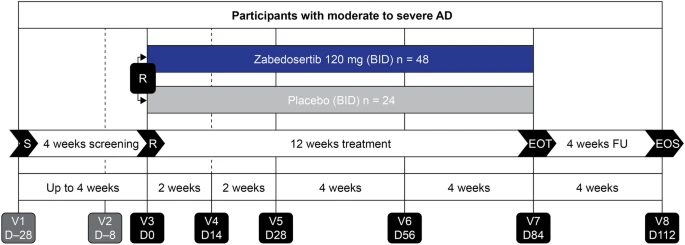Moderate-to-severe Atopic Dermatitis (AD) remains a challenging condition to treat, with existing therapeutic options often presenting limitations such as relapse after withdrawal, significant toxicities, or requiring parenteral administration. Conventional systemic immunosuppressants are associated with nephrotoxicity, myelosuppression, and gastrointestinal symptoms, while biologic agents may lead to conjunctivitis and limited efficacy. Janus kinase inhibitors, another class of treatments, carry risks of severe infections, non-melanoma skin cancer, and thromboembolism, necessitating continuous blood monitoring.
Inhibition of Interleukin-1 receptor-associated kinase 4 (IRAK4) has emerged as a novel and promising therapeutic approach. IRAK4 is a key kinase that regulates the production of proinflammatory cytokines and mediates intracellular signal transduction pathways for innate immune cell receptors like IL-1 receptor and Toll-like receptors. Preclinical studies demonstrated that IRAK4 inhibition could attenuate skin inflammatory processes in AD-like animal models. Furthermore, zabedosertib (BAY1834845), a potent and selective IRAK4 inhibitor, significantly suppressed markers of local and systemic immune responses in healthy human volunteers after induced inflammation, suggesting a strong anti-inflammatory effect in humans. These findings supported the evaluation of zabedosertib as a potential treatment for AD.
Methods
The DAMASK study (NCT05656911) was a 12-week, randomized, double-blind, placebo-controlled, phase 2a, proof-of-concept study. Adult patients (18-65 years) with moderate-to-severe AD, inadequately controlled by topical corticosteroids, were randomized in a 2:1 ratio to receive oral zabedosertib 120 mg twice daily or placebo. The primary efficacy endpoint was a composite of achieving 75% reduction from baseline on the Eczema Area and Severity Index (EASI-75), no discontinuation due to lack of efficacy, no rescue medication use in the 4 weeks before Day 84, and no initiation of systemic AD treatment.
Key Findings
• Efficacy: At Week 12, there was no significant difference between zabedosertib and placebo in the primary efficacy endpoint (EASI-75 response: 32.3% for zabedosertib vs. 37.4% for placebo). Similarly, no significant differences were observed for other efficacy measures including vIGA-AD response (15.9% vs. 28.5%), Peak Pruritus response (16.4% vs. 25.0%), percentage change in Peak Pruritus (−20.7% vs. −27.3%), or percentage change in affected body surface area (−13.3% vs. −20.3%).
• Safety and Tolerability: Zabedosertib was found to be safe and well tolerated. No severe or serious treatment-emergent adverse events (TEAEs) were reported in either treatment arm throughout the study. The incidence of study drug-related adverse events was comparable between the two arms. The most frequently reported TEAEs were in the System Organ Classes of infections and infestations and gastrointestinal disorders.
• Biomarkers: Analysis of plasma biomarkers for inflammation and AD-specific markers (e.g., IL-31/33, IL-4, IL-6, TNFα) showed no relevant difference in the ratio to baseline between zabedosertib and placebo. An optional substudy on skin biopsies also provided no significantly different gene expression.
• Pharmacokinetics: Plasma concentrations of zabedosertib were within the expected range, consistent with previous phase 1 studies.
Despite the negative findings for AD, the favorable safety and tolerability profile of zabedosertib, coupled with its proven anti-inflammatory effects in other contexts, suggests future implications for its potential in other immune-mediated diseases. Conditions where MyD88-dependent TLR/IL-1R signaling is more prominent, such as cutaneous lupus or pustular psoriasis, may still benefit from IRAK4 inhibition and warrant further exploration for zabedosertib. The ongoing studies with IRAK4 degraders in AD and other immune-mediated indications will also provide critical insights into the precise role of IRAK4 and whether a more complete inhibition of its functions could yield clinical efficacy.

In the figure: Study design. AD, atopic dermatitis; BID, twice daily; FU, follow-up; EOS, end of study; EOT, end of treatment; S, screening; R, randomization; V, visit
Link to the study: https://tinyurl.com/yx7fd8yb
